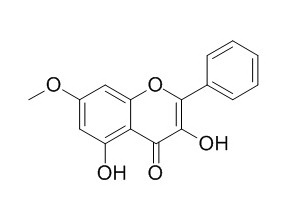Izalpinine
Izalpinin exhibits potent antioxidant activities in the 1,1-diphenyl-2-picrylhydrazyl (DPPH) assay. Izalpinin exhibits inhibitory role of muscarinic receptor-related detrusor contractile activity, and it may be a promising lead compound to treat overactive bladder.
Inquire / Order:
manager@chemfaces.com
Technical Inquiries:
service@chemfaces.com
Tel:
+86-27-84237783
Fax:
+86-27-84254680
Address:
1 Building, No. 83, CheCheng Rd., Wuhan Economic and Technological Development Zone, Wuhan, Hubei 430056, PRC
Providing storage is as stated on the product vial and the vial is kept tightly sealed, the product can be stored for up to
24 months(2-8C).
Wherever possible, you should prepare and use solutions on the same day. However, if you need to make up stock solutions in advance, we recommend that you store the solution as aliquots in tightly sealed vials at -20C. Generally, these will be useable for up to two weeks. Before use, and prior to opening the vial we recommend that you allow your product to equilibrate to room temperature for at least 1 hour.
Need more advice on solubility, usage and handling? Please email to: service@chemfaces.com
The packaging of the product may have turned upside down during transportation, resulting in the natural compounds adhering to the neck or cap of the vial. take the vial out of its packaging and gently shake to let the compounds fall to the bottom of the vial. for liquid products, centrifuge at 200-500 RPM to gather the liquid at the bottom of the vial. try to avoid loss or contamination during handling.
Nutrients.2024, 16(14):2267.
Food Chem X.2024, 21:101127.
In Vitro Cellular & Developmental Biology - Plant2022, 58:972-988.
Wageningen University & Research2018, January 2018
Advances in Traditional Medicine2020, 10.1007
Redox Rep.2024, 29(1):2392329.
Molecules.2020, 25(11):2599.
Front Immunol. 2020, 11:62.
Processes2024, 12(8), 1563
Molecules.2023, 28(16):6025.
Related and Featured Products
Afr J Tradit Complement Altern Med. 2014 Jun 4;11(4):120-5.
Izalpinin from fruits of Alpinia oxyphylla with antagonistic activity against the rat bladder contractility.[Pubmed:
25392590 ]
Alpinia oxyphylla (Zingiberaceae), an herbaceous perennial plant, its capsular fruit is commonly used in traditional Chinese medicine for the treatment of different urinary incontinence symptoms including frequency, urgency and nocturia. These symptoms are similar to the overactive bladder syndrome. In our lab, we found that the 95% ethanol extract of the capsular fruits exhibited significant anti-muscarinic activity. Some constituents in capsular fruits including flavonoids (e.g., izalpinin(Izalpinine) and tectochrysin), diarylheptanoids (e.g., yakuchinone A and yakuchinone B) and sesquiterpenes (e.g., nootkatone), are regarded as representative chemicals with putative pharmacological activities.Carbachol induced concentration-dependent contractions of isolated rat bladder detrusor strips. The vehicle DMSO had no impact on the contraction response. The contraction effects were concentration-dependently antagonized by izalpinin, with a mean EC50 value of 0.35 μM. The corresponding cumulative agonist concentration-response curves shifted right-ward.
CONCLUSIONS:
Izalpinin(Izalpinine) exhibits inhibitory role of muscarinic receptor-related detrusor contractile activity, and it may be a promising lead compound to treat overactive bladder.
J Asian Nat Prod Res. 2013;15(10):1094-9.
Two new antioxidant diarylheptanoids from the fruits of Alpinia oxyphylla.[Pubmed:
23869536 ]
METHODS AND RESULTS:
Two new diarylheptanoids, 1-(3',5'-dihydroxy-4'-methoxyphenyl)-7-phenyl-3-heptanone (1) and 1-(2',4'-dihydroxy-3'-methoxyphenyl)-7-(4″-methoxyphenyl)-3-heptanone (2), along with known diarylheptanoid yakuchinone A (3), and five flavanoids, tectochrysin (4), chrysin (5), izalpinin (Izalpinine,6), kaempferol 7, 4'-dimethyl ether (7), and kaempferide (8) were isolated from the fruits of Alpinia oxyphylla Miq. Their structures were determined by means of spectroscopic methods.
CONCLUSIONS:
Antioxidant activities of all the isolated compounds were evaluated using a 1,1-diphenyl-2-picrylhydrazyl (DPPH) assay. Compounds 1-3 and 6-8 exhibited potent antioxidant activities in the DPPH assay.



